
DanielPrudek / iStock / Getty Images Plus
Scientists Have Decoded the Universal Language of Honey Bees
Scientists just made a real-life breakthrough in understanding how bees talk to each other. Learn more about decoding the honey bee waggle dance.
A world where bees and humans can communicate might sound like something straight out of a children's animated film ("Bee Movie," anyone?). But scientists just made a real-life breakthrough in understanding how bees talk to each other. In a paper appearing in the April edition of Animal Behavior, researchers shared the discovery of a universal calibration that makes it possible to decode honey bee waggle dances across sub-species and landscapes. While we won't be talking to bees anytime soon, this finding could help us maintain existing bee populations.

Sanka Vidanagama/NurPhoto
Dance, Honey Bee, Dance
If you're not an apiarist, you may be wondering what in the world a waggle dance is. When a worker bee finds a new nectar source nearby, it dances in a distinctive figure-eight pattern to alert other bees of the good news. There's even a designated "dance floor" near the entrance of the hive where waggle dances take place.
Honey bees aren't waggling willy-nilly, though. Certain aspects of the dance communicate details about the nectar source. How long the dance lasts corresponds with the distance to the source, for instance, and the angle of the bee's dancing body relative to the sun indicates the direction of the source. We've known that part for a while; Austrian zoologist Karl von Frisch won a Nobel Prize in 1973 for being the first to discover the meaning of waggle dances.
Until recently, von Frisch's model was the "bee-all" and end-all of waggle dance decoding. However, Virginia Tech researchers Margaret Couvillon and Roger Schürch noticed that bees communicating the same nectar source sometimes vary their waggle dances.
The husband-and-wife duo decided to develop their own "distance-duration calibration system" that factored in "noise," or variation between bees who visit the same source. They discovered that that bee-to-bee variation is so high, it renders the location and sub-species of the bee biologically irrelevant. That made it possible for them to create a universal calibration for decoding waggle dances.
More on Bees
These Bee Chicas Are Colorado’s Local Heroes
Last year, US beekeepers lost almost 40% of their bee colonies. Four women banded together to help the bee population flourish in Colorado.
Save the Bees, Please
Why would humans want to understand bees, anyway? To start, the universal calibration makes it possible for researchers worldwide to understand where bees are collecting food. This knowledge can inform bee-friendly planting practices.
Understanding waggle dances also makes it possible to use bees as a way to monitor the environment, Couvillon said in a press release.
"The bees can tell us in high spatial and temporal resolution where forage is available and at what times of the year," she said. "So, if you want to build a mall for example, we would know if prime pollinator habitat would be destroyed. And, where bees forage, other species forage as well. Conservation efforts can follow."
And why save the bees? According to Greenpeace USA, 70 out of the top 100 food crops are pollinated by bees. If you do the math, that means bees are responsible for one of every three bites of food you eat. The biggest threats to bees right now are pesticides and habitat loss, which could be minimized by using information about where bees forage.
Couvillon and Schürch's latest decoding model doesn't give real-time information about where bees go, as it takes some time and effort to videotape and analyze waggle dances. But they're hoping to streamline the process so that one day, they'll be able to track bees instantaneously.
This article first appeared on Curiosity.com.



















